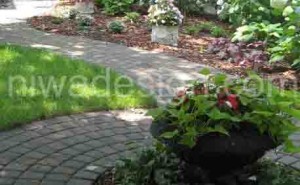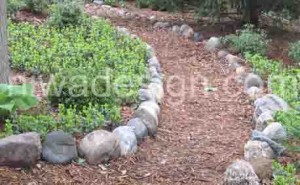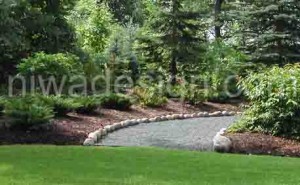Garden Paths – Designs that make your Garden Look More Attractive
 April 25, 2012
April 25, 2012
Creating a beautiful garden needs great effort and after proper design. I enjoy garden that begs to be explored. The garden path in a garden allows visitors to explore the garden in a very easy and interesting way. These paths can be inviting and will lead the visitor throughout the garden, allowing them to see the beautiful colors, plants and discover potential surprises within. Creating a wonderful garden path in your Minnesota garden adds an excellent opportunity to guide visitors and direct traffic the way you want.
Garden pathway materials to consider?
Garden paths can be designed using a wide variety of materials. However, for any type of garden path you will need to prepare the area. For many path materials such as brick pavers or stone, a thin 1†layer of sand for leveling over compacted class v will make a perfect base. If you choose to lay cement you may need additional preparation. You have the choice of choosing among the varied items like bricks, clay or concrete in different colors and designs. Concrete pavers come in a variety of designed shapes like round, hexagonal, square, interlocking shapes, rectangular, artificial stone paving blocks, terra-cotta tiles, glazed accent tiles, pored and tinted tiles can also be used while designing your garden paths.
Another class of materials that can be used for your garden pathways inMinnesotais the organic choices like grass, hard-packed earth and wood. While choosing wood, you can choose any of the forms like shredded bark, wood chips, cut rounds of tree trucks, and smooth finished decking for bridges and boardwalks and rough-sawn planks.
Another natural material to consider, which I have used in many garden is gravel. Â Gravel pathways are excellent for many gardens especially Japanese gardens. Â There are numerous local options available for gravel paths such as a buff limestone, orange-red limestone, granite, trap rock and a light gray limestone. Â I also recommend using a smaller size that is comfortable to walk on.
Where to use paths and how to establish a hierarchy system?
Garden paths are one way to connect some of the various places in the garden to achieve a sense of order and cohesiveness. While working for a new or reworked design, you can put down paths anywhere in your garden. You need to make sure that you have a logical succession from one area to the next to get a pleasing and satisfactory result.
One primary path to take into consideration is from your back door to your back yard. You may have separate paths leading off to different areas such as a fountain in the middle of a lush green lawn, a secluded corner where you can sit under a shade tree and read a book or even to the vegetable plot, or water garden. It’s a good idea to have any garden paths that lead off the main path narrower in size. Â Â Create a hierarchy with your path system with the primary pathway being the widest, then a secondary width and possible a tertiary width.
How should you design your garden pathways?
You can design your garden paths using both rectilinear and curvilinear lines. Rectilinear paths are based on straight lines and often feel more structured. Â Curvilinear paths will have curved lines and typically feel more free flowing especially when using free flowing sweeping turns. Â It is easier to have guests walking in the garden on a curvilinear path to have a more exploratory experience in the garden. Designing a curvilinear path in the deep interiors where you will have garden elements that are somewhat hidden can be an enjoyable experience of discovery. Â Rectilinear paths work well in formal more structured gardens and often have opportunities at the end of long walks to feature a strong garden element, such as; sculptures, statues, decorative pots, water features, benches and other artistic interesting elements.
What about decorating your garden pathways?
While designing your garden path you can follow some decorating tricks to attract visitor into your garden. Leave place where no one can expect, for example, as the path curves round place a piece of art along the side of the path and possibly use a true specimen plant around another bend, continuously offering something of interest along the way. This gives user of the pathway a few surprises while walking the path. Don’t forget adding some lighting along your garden paths. If you have a tighter budget you can use expensive solar lights that do not need wiring back to a power source, which makes this job very easy. In a Monet garden project we planted climbing roses over a series of archways. Â You could also add a stone wall along a section of your path. There are many ideas and possibilities which can make your garden interesting and exciting. Repeating splashes of color will also make you establish a rhythm in the garden and will be helpful to guide the eye to the next surprise along the path.
If you are interested in this fountain product please contact us
You can also visit Japanese Garden Journal for more information about Japanese Gardens.



 Posted in
Posted in  content rss
content rss